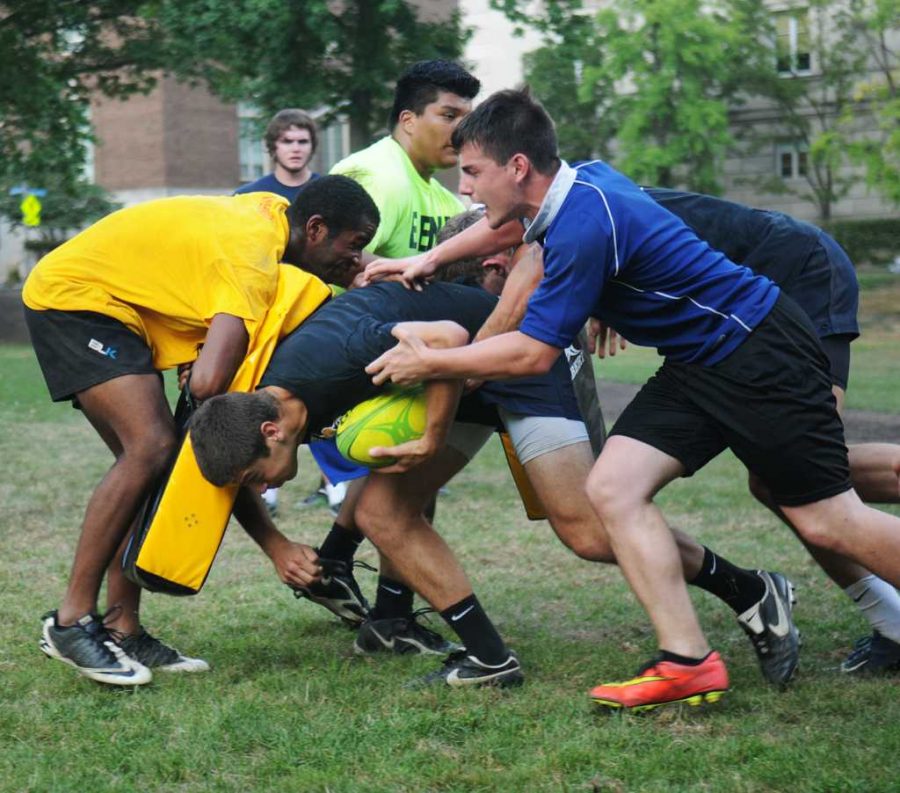Editors note: This is the first in a two part series about Pitt Rugby.
I knew I should have packed my cleats.
After endeavouring to partake in a University of Pittsburgh Rugby Football Club’s practice, in the style of late participatory journalist George Plimpton, I had asked a friend who played rugby what I would need.
“Cleats and a mouth guard,” he responded matter-of-factly.
After nonchalantly deciding to go without either, the first thing the team’s president, Aidan Nuttall, said when he saw me was “Do you have cleats?”
It was not the best start.
Still, I hadn’t played any sort of organized sport — much less rugby — since fifth grade.
But while time — or a lack thereof — got the better of me, the desire remained to play the rough and physical sport.
Plimpton made a career out of, in conductor Leonard Bernstein’s words, being a “professional amateur” — trying an activity, like professional baseball or stand up comedy, with only an inkling of talent, and then writing about the experience.
But I was jumping into an activity I knew very little about the game, aside from its fast pace and constant contact. But how do people actually play? Well, I didn’t have a clue. If Plimpton was a professional amateur, what would I be? An amateur amateur?
So, after clearing the story with my editors and emailing Nuttall, I trotted off to a practice on Sept. 8, heading to the field on a hot fall night. Upon arrival, I joined in on a group of 15 or so team members tossing the oblong shape ball to each other, easing into the practice. Being the friendly sort, they threw the ball toward me. Being the absent-minded sort, I didn’t think it was thrown to me.
It went kicking off into the dirt behind us. I scrambled to pick it up and pass it back in.
This repeated two more times.
The team moved onto some light calisthenics, the type I hadn’t done since my last attempt at organized sports — a football tryout in high school. Forwards captain Dave Zimmerman, simply called “Big Dave” by team members, led us in high knees and lunges — simple enough stuff even for this amateur.
Big Dave stands more than 6-foot foot, and the cut-off T-shirts he wears show a sculpted physique.
“I always wanted to play since high school, my parents never let me, because they thought it was too physical. Then I came to college, I was like ‘Ha, mom and dad can’t stop me now,’” Zimmerman said. “I joined Pitt rugby and I’ve been with them ever since.”
His size is important as a forward. Generally speaking, teams divide rugby players into forwards and backs. Forwards are bigger guys, as they require the size to rough up the opposition, while the backs are smaller and quicker, as their game is more predicated on darting to and fro. Following the various heart rate-rising drills, our bodies were better prepared to scrum., We gathered around the two coaches, Allan Murray and Derek Neubauer, as they went over last week’s game against Indiana University of Pennsylvania.
Pitt’s team is Division I-AA. This means they are at the highest level a non-varsity program can play. Single-A teams are full varsity programs, with players on scholarships. Pitt’s players, meanwhile, play entirely of their own accord.
Ohio State, for example, is in Division I-A and was Pitt’s upcoming game that week.
For Nuttall, becoming Division I-A is always a goal.
“That is absolutely something that we’d like to do,” the rugby president said.
The team plays two games per scheduled match, an A-side and B-side game. A-side tends to include more skilled, veteran players, while B-side consists of everyone else who makes the trip.
“We play an A-side game, which is the game that counts, and a B-side game, which doesn’t count for the record and is more to get everybody else to play,” Todd said.
As someone who knew very little about the sport, I could tell I’d be a long way off from A-side. But that is usually the case for novices. According to Todd, only four to five players had played rugby before playing at Pitt. He is one of them, which allowed him to start as a freshman on A-side.
Is this normal?
“No, not really. I was the only one last year,” Todd said.
Murray, who has played rugby since his sophomore year at Slippery Rock University and has been coaching since 2005, correlates the lack of experienced players to the on the nature of the sport.
“It’s a really easy game to learn, but it’s a really difficult game to master,” Murray said.
Most freshman are like Windsor Dalrymple, an undeclared freshman. He played soccer and threw javelin in high school and was looking for a way to stay active in college. Then, the rugby team found him.
“When I was moving into Towers, they had a tent set up on the patio, and they approached me and said, ‘Hey, you look like you’d want to play rugby, have you thought about it?’” Dalrymple said.
Having players with prior rugby experience is rare, Todd said, and the team scouts for potential converts among other former high school stars.
“We have people come from all different sports. A lot of them come from football, wrestling and track … I think there was a tennis kid,” Todd said.
But even the prior athletic commitment was unnecessary.
“Some of them didn’t even play sports, and they just picked up rugby”, Todd said.
Some them didn’t even play sports? Maybe there was hope for the amateur amateur after all.
Pick up The Pitt News tomorrow for part two of this immersive adventure.



